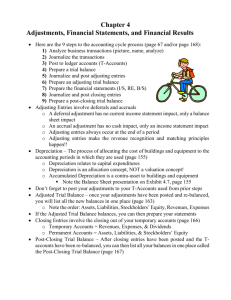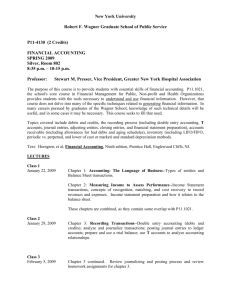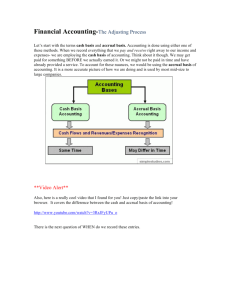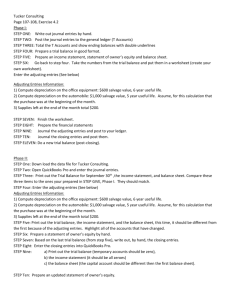Financial Accounting and Information Systems - iba
advertisement
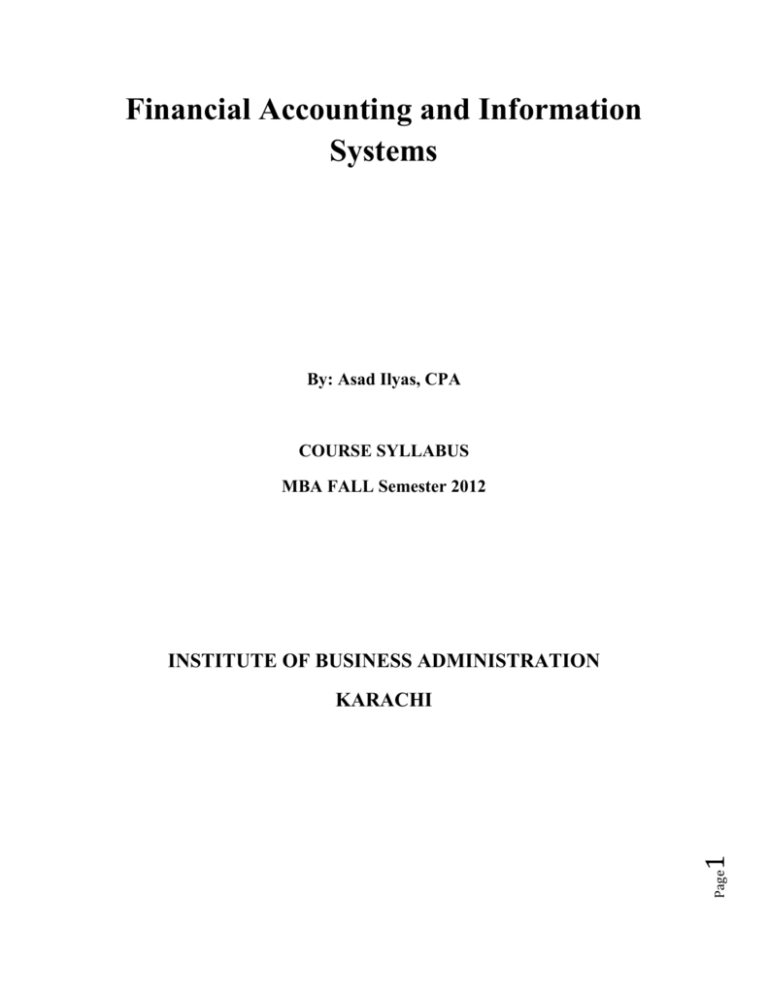
Financial Accounting and Information Systems By: Asad Ilyas, CPA COURSE SYLLABUS MBA FALL Semester 2012 INSTITUTE OF BUSINESS ADMINISTRATION Page 1 KARACHI Course Framework The course’s framework is based on a model of the accounting process in a business setting. The model views financial accounting as a financial information system that tracks and records an organizations business transactions and aggregates them into reports for decision makers both inside and outside the business. A transaction is an event that has consequences for a business financial condition. The course materials are presented in two modules. Module 1: The initial 13 sessions cover the accounting basics, such as basic accounting concepts and the nature and preparation of the balance sheet, income statement and the statement of cash flows. Module 2: The second part from session 14 through to session 24 (11 Case Studies) cover more advanced accounting practices that the user will encounter through case studies. Course Text 1 - www.principlesofaccounting.com (Introduction) principlesofaccounting.com and Utah State University (USU) have come together for a high quality introductory financial accounting course. Each chapter consists of related text, basic and involved exercises. All the chapters are also tagged with a Lecture Video by a representative of USU 2 – Cases Page 2 Case descriptions are posted for each session. All cases would be available on the yahoo group Session 1-2 Introduction to Accounting Concepts: Accounting Definition, Accounting Equation, Financial versus Managerial Accounting, Users and their Objectives, Financial Accounting Objective Reading Material: www.principlesofaccounting.com Chapter 1 (Accounting Cycle): Textbook for Chapter 1 Study Guide: o Goals Achievements o Fill in the Blanks o Multiple Choice Assignments: o Problems B-01.01 – B-01.09 o Problems I-01.02, I-01.03, I-01.08 Session 3 Introduction to Accounting Concepts: Financial Statements (BS, IS and SCF), Recording process concept (Debit/Credit, General Journal, General Ledger and Trial Balance) www.principlesofaccounting.com Chapter 2 (Information Processing): Textbook for Chapter 2 Study Guide: o Goals Achievements o Fill in the Blanks Assignments: 3 o Multiple Choice Page Reading Material: o Problems B-02.01 – B-02.09 o Problems I-02.01, I-01.02, I-02.08 Session 4 - 5 Accounting Principles: Accrual Basis of Accounting (Timing, types, recognition and classification of revenues and expenses); Main Principles (Matching, Materiality, Consistency and Conservatism); Accounting Policies, estimates and errors Reading Material: www.principlesofaccounting.com Chapter 3 (Income Measurement): Textbook for Chapter 3 Study Guide: o Goals Achievements o Fill in the Blanks o Multiple Choice Assignments: o Problems B-03.01 – B-02.10 o Problems I-03.01, I-03.04, I-03.06 and I-03.07 Session 6 – 8 Accounting Cycle Recording: Identify, Analyze Transactions, Journal Entries; Posting to Ledger, Trial balance, Financial Statements; Closing Entries (Soft Closing vs Hard Closing), After closing Trial Balance Page Accounting Cycle Closing: Closing of Temporary Accounts, Generation of Financial Statements 4 Accounting Cycle Adjusting Entries concept: Trial Balance phase adjusting entries, Balance Sheet items adjusting entries, income statement items adjusting entries, Error items adjusting entries Reading Material: www.principlesofaccounting.com Chapter 4 (The Reporting Cycle): Textbook for Chapter 4 Study Guide: o Goals Achievements o Fill in the Blanks o Multiple Choice Assignments: o Problems B-04.01 – B-02.09 o Problems I-04.01, I-04.02, I-04.5 and I-04.07 Session 9 Property Plant and Equipment and Depreciation: Acquisition, Disposal and Depreciation of Assets; Gain or Losses on Sale of Assets; Impairment Testing www.principlesofaccounting.com Chapter 10 (Property, Plant and Equipment): Textbook for Chapter 10 Study Guide: o Goals Achievements o Fill in the Blanks o Multiple Choice Assignments: o Problems B-10.01 – B-10.09 o Problems I-10.01 to I-10.05 (5 exercises) 5 Page Reading Material: Session 10 Accounts Receivable: Estimating bad debt expenses under different methods; Quality of A/R; A/R Turnover and average collection period Reading Material: www.principlesofaccounting.com Chapter 7 (A/R): Textbook for Chapter 7 Study Guide: o Goals Achievements o Fill in the Blanks o Multiple Choice Assignments: o Problems B-07.01 – B-07.11 o Problems I-07.01 to I-07.04 Session 11 Inventory Management: Valuation of Inventories; Measurement of COGS, Issues in inventory Management; Periodic and Perpetual Inventory systems www.principlesofaccounting.com Chapter 8 (Inventory): Textbook for Chapter 8 Study Guide: o Goals Achievements o Fill in the Blanks Assignments: 6 o Multiple Choice Page Reading Material: o Problems B-08.01 – B-08.12 o Problems I-08.01 to I-08.03 and I-08.05 Session 12 – 13 Business Organizations: Sole proprietorships, Partnerships and Corporations; Introduction to Partnerships; Current and Capital Accounts; Profit and Loss appropriation exercises; dissolution; changes in partnerships and its effects on the composition of a firm; concepts of goodwill Reading Material: www.principlesofaccounting.com Chapter 3 (Income Measurement): Textbook for Chapter 3 Study Guide: o Goals Achievements o Fill in the Blanks o Multiple Choice Assignments: o Problems B-03.01 – B-02.10 o Problems I-03.01, I-03.04, I-03.06 and I-03.07 Session 14 Introduction to Business Activities and Overview of Financial Statements and the Reporting Process Page 7 Thumbs-Up Video Inc: A Start up video rental business is described to provide a basis for a bookkeeping and financial reporting exercise for an accounting course. Both start-up and operating transactions are included along with situations requiring judgments about depreciation policies and end of period adjustments Session 15 Balance Sheet: Presenting the Investments and Financing of a Firm Maria Hernandez & Associates: This case presents the situation of an unemployed web page designer who starts a new consulting firm with personal savings and a family loan. Two months later, she is to report on operations to her father, using financial reports she must design and construct Session 16 Income Statement: Reporting the Results of Operating Activities Chemalite, Inc: A chemical engineer who has set up a company to manufacture and market one of his inventions is trying to prepare his state of the corporation report. This case is designed to serve as a vehicle to introduce students to basic bookkeeping and accounting functions Session 17 Reporting the Effects of Operating, Investing and Financing activities on Cash Flows Statement of Cash Flows (Three Examples): This case introduces the statement of cash flows through three examples of multi-year statements of cash flows from three unidentified companies Session 18 Introduction to Financial Statement Analysis Colgate-Palmolive Co: Analyzing an Annual Report: United States; Global; $7.6 billion revenues 1994 Page 8 A directed analysis of the Colgate-Palmolive Co. annual report. Focuses on the basics of reading an annual report including analysis of financial statements, calculations of financial ratios and study of the layout and message of the report. Industry financial ratios are included for comparison Session 19 Receivables and Revenue Recognition Circuit City Stores, Inc. (A): Retail Industry; Large; $2 Billion sales Circuit City sells consumer electronic equipment, appliances and extended service and warranty contracts which supplement those provided by equipment manufacturers. Equipment is sold at low margins, while warranties carry very high margins. A question has been raised about the proper method for recognizing revenues on the warranty portion of the combined sale. Deferring revenue will cur profit reported at the time of sales but may better match costs of warranty service Session 20 Inventories: The source of Operating Profits Seitel, Inc: Petroleum industry; Natural Gas; $33 Million revenues The company’s accounting for its seismic data library is questioned. Learning Objective Inventory Accounting Session 21 Inventories: The source of Operating Profits Summit Distributors (A); Mid Size $150 Million in Revenues Summit Distributors was in danger of violating loan covenants because of slow economic activity and forecasted losses and was faced with a choice. Changing the inventory valuation method from LIFO to FIFO would avoid default but would require higher future income taxes. Not changing could mean default on covenants, renegotiating loan terms at less favorable interest rates or possible bankruptcy Depreciation at Delta and Pan Am; Airline Industry Page Long Lived Tangible and Intangible assets: the source of Operating Capacity 9 Session 22-23 Depreciation policies of Delta Air Lines and Pan Am Corp are compared and contrasted against a summary of operating data from each airline. Questions with the case require projection of future depreciation on a new aircraft using the policies of each company Session 24-25 Liabilities: Introduction Accounting for the Intel Pentium Chip Flaw; Computer Industry, $8.7 Billion revenues 1994 Investigates the 1994 Intel Pentium plan. To encourage discussion of whether Intel should provide a wide recall and if so, what this would cost. To examine the accounting implications of this decision using a FAS #5 (contingent liability) framework Session 25-26 Shareholder’s Equity: Capital Contributions, Distributions and Earnings Butler Capital Partners and Auto-distribution: Putting Private Equity to work in France Describes a proposed buyout transaction of Auto-distribution, an entrepreneurial firm that is the leading car parts distributor in France. The deal became feasible because of a failed takeover battle for auto distribution’s parent company. Private equity investor Butler Capital partners must make an investment decision within three weeks. Other private equity firms compete with Butler for the deal. Butler must assess the potential for margin improvement and expansion within France and to other European Countries. Furthermore, since the price of the deal is set, Butler must focus on finding an advantageous structure for all parties to secure the deal Session 27 – 28 Page 10 Course Overview Grading Class Participation 25% Quizzes 10% Assignments 10% Mid Term / WAC 20% Final Exam 35% Quizzes Quizzes most of the times will be unannounced but expect more than 5 quizzes during the semester. My target would be to take at least 10 quizzes. There will be no retake if you miss a class. Assignments Assignments for each session are due the session before. For example; homework and reading assignments for session 4-5 is due at the beginning of session 3. This will ensure that you have prepared for the lecture or the case and are ready for active participation. Class Participation Conduct: Each session will be of 90 minutes and the doors will be locked 1 min prior to the start time of the class. There will be zero tolerance for tardiness. There will be no retake If you miss an quiz, assignments or class. Rules: Page 2. Your class participation will help you develop your communication skills, your critical thinking skills and build your self-confidence. Every class is a chance to polish your functional knowledge and leadership skills. Therefore, please take responsibility of your own development 11 1. You will only raise your hand in the class and will speak only when acknowledged 3. It is extremely important that you follow instructions to the tee. CP and WAC Grading: (0-5) 1. Weak (0-1) o Poor class participation o Mostly cold calls o Wrong Facts / data in class about the case o Creating disruption and not allowing others participants to speak 2. Adequate to Good (1-2) o Shows comprehension of the case and the reading o Speaks in a coherent manner o Present ideas and arguments clearly o Provides key elements of the case, basic facts / knowledge of the case during the discussion 3. Very Good (2-3) o Shows advance level of case knowledge o Shows basic competence in synthesis and critical thinking o Logically organized ideas o Clear thoughts about the case issues and analysis of different alternatives o Confidently defending argument and position in class discussion 4. Excellent (3-4) o Well organized and structured ideas with no errors o Able to perform critical analyses, identification of dilemmas and tension points Page o Strong evidence of critical thinking and intellect 12 o Shows clear understanding about case concepts (Both core issues and conceptual issues) o Able to indentify paradoxes and build thinking around it o Builds arguments from thinking two opposite ideas at the same time during the class discussions o Shows synthesis – connections amount various details and ideas o Shows ability to develop an idea, build content and substance and able to develop real application and action plan 5. Exceptional in all respect (4-5) o Original thinking and creative ideas and sound action planning abilities o Generated new thinking in the class and added new dimension in the class discussion about the case o Very high level of synthesis of ideas and application o Extension of the case / class contents / objectives Page 13 o Demonstrates very high level of intellectual rigor in the class Summary of Sessions Session Topic 1 Introduction to Accounting Concepts: Accounting Definition, Accounting Equation, Financial versus Managerial Accounting, Users and their objectives, Financial Accounting Objective Introduction to Accounting Concepts: 3 Financial Statements (BS, IS and SCF) Recording Process Concept (Debit/Credit, General Journal, General Ledger and Trial Balance) Accounting Principles: 4-5 Accrual Basis of Accounting (Timing, types, recognition and classification of revenues and expenses) Main Principles (Matching, Materiality, Consistency and Conservatism) Accounting Policies, estimates and errors Accounting Cycle: Recording Identify, Analyze Transactions, Journal Entries Posting to Ledger, Trial Balance, Financial Statements Closing Entries (closing income statement items), After-Closing Trial Balance 6-8 Accounting Cycle: Adjusting entries concept Trial balance phase adjusting entries, Balance Sheet items adjusting entries Income statement items adjusting entries, Error items adjusting entries Accounting Cycle: Closing Closing of Temporary Accounts, Generation of Financial Statements Property, Plant and Equipment & Depreciation: Acquisition, disposal and depreciation of assets 9 Gains or losses on sale of assets Impairment Testing Accounts Receivable: Estimating Bad Debt Expenses under different methods 10 Quality of A/R Accounts Receivable turnover and average collection period Inventory Management: (Part 1) Valuation of Inventories 11 Measurement of Cost of Goods Sold, Issues in inventory Management Inventory Management: (Part 2) Periodic and Perpetual inventory systems Sole Proprietorships, Partnerships & Corporations Introduction to Partnerships Page 12 14 Business Organizations: Topic Session 14 Case 1 15 Case 2 16 Case 3 17 Case 4 18 Case 5 19 Case 6 20 Case 7 21 Case 8 22 Case 9 23 Case 10 24 Case 11 Course Review 15 27-28 Page 13 Partnerships: Current & Capital Accounts Profit & Loss Appropriation Exercises Dissolution Change in partnerships and its effects on the composition of a firm Concepts of Goodwill

